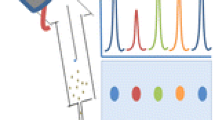Abstract
Direct coupling of thin-layer chromatography (TLC) with matrix-assisted laser desorption ionization (MALDI) mass spectrometry allows fast and detailed characterization of a large variety of analytes. The use of this technique, however, presents great challenges in semiquantitative applications because of the complex phenomena occurring at the TLC surface. In our laboratory, we recently observed that the ion intensities of several alkali adduct ions were significantly different between the top and interior layer of the TLC plate. This indicates that the integrity of the TLC surface can have an important effect on the reproducibility of TLC- MALDI analyses.

MALDI imaging reveals that surface integrity affects the detection of alkali adductions in TLC-MALDI.





Similar content being viewed by others
References
Griesinger H, Fuchs B, Süß R, Matheis K, Schulz M, Schiller J. Stationary phase thickness determines the quality of thin-layer chromatography/matrix-assisted laser desorption and ionization mass spectra of lipids. Anal Biochem. 2014;451:45–7.
Fuchs B, Schiller J, Süß R, Schürenberg M, Suckau D. A direct and simple method of coupling matrix-assisted laser desorption and ionization time-of-flight mass spectrometry (MALDI-TOF MS) to thin-layer chromatography (TLC) for the analysis of phospholipids from egg yolk. Anal Bioanal Chem. 2007;389(3):827–34.
Leriche E-D, Hubert-Roux M, Grossel MC, Lange CM, Afonso C, Loutelier-Bourhis C. Direct TLC/MALDI–MS coupling for modified polyamidoamine dendrimers analyses. Anal Chim Acta. 2014;808:144–50.
Bischoff A, Eibisch M, Fuchs B, et al. A simple TLC-MALDI method to monitor oxidation products of phosphatidylcholines and -ethanolamines. Acta Chromatogr. 2011;23(2):365–75.
Fuchs B, Süß R, Nimptsch A, Schiller J. MALDI-TOF-MS directly combined with TLC: a review of the current state. Chromatographia. 2009;69(1):95–105.
Matheis K, Fuchs B, Lemmnitzer K, Süss R, Griesinger H, Minarik S, et al. Combining TLC separation with MS detection-a revival of TLC. J Glycomics Lipidomics. 2015;2015.
Kondakova T, Merlet-Machour N, Chapelle M, et al. A new study of the bacterial lipidome: HPTLC-MALDI-TOF imaging enlightening the presence of phosphatidylcholine in airborne Pseudomonas fluorescens MFAF76a. Res Microbiol. 2015;166(1):1–8.
Morschheuser L, Mükusch S, Riedner M, Seitz H, Rohn S. High-performance thin-layer chromatography as a fast screening tool for phosphorylated peptides. J Chromatogr B. 2016;1008:198–205.
Van Berkel GJ, Ford MJ, Deibel MA. Thin-layer chromatography and mass spectrometry coupled using desorption electrospray ionization. Anal Chem. 2005;77(5):1207–15.
Seng JA, Ellis SR, Hughes JR, et al. Characterisation of sphingolipids in the human lens by thin layer chromatography–desorption electrospray ionisation mass spectrometry. Biochim Biophys Acta. 2014;1841(9):1285–91.
Bagatela BS, Lopes AP, Cabral EC, Perazzo FF, Ifa DR. High-performance thin-layer chromatography/desorption electrospray ionization mass spectrometry imaging of the crude extract from the peels of Citrus aurantium L. (Rutaceae). Rapid Commun Mass Spectrom. 2015;29(16):1530–4.
Fuchs B, Schiller J, Süß R, et al. Analysis of stem cell lipids by offline HPTLC-MALDI-TOF MS. Anal Bioanal Chem. 2008;392(5):849–60.
Fuchs B, Schiller J, Süß R, Nimptsch A, Schürenberg M, Suckau D. Capabilities and disadvantages of combined matrix-assisted laser-desorption/ionization time-of-flight mass spectrometry (MALDI-TOF MS) and high-performance thin-layer chromatography (HPTLC): analysis of egg yolk lipids. JPC. 2009;22(1):35–42.
Crecelius A, Clench MR, Richards DS, Parr V. Quantitative determination of piroxicam by TLC–MALDI TOF MS. J Pharm Biomed Anal. 2004;35(1):31–9.
Wegener J, Zschörnig K, Onischke K, Fuchs B, Schiller J, Müller K. Conservation of honey bee (Apis mellifera) sperm phospholipids during storage in the bee queen—A TLC/MALDI–TOF MS study. Exp Gerontol. 2013;48(2):213–22.
Yu Y, Vidalino L, Anesi A, Macchi P, Guella G. A lipidomics investigation of the induced hypoxia stress on HeLa cells by using MS and NMR techniques. Mol BioSyst. 2014;10(4):878–90.
Flaim G, Obertegger U, Guella G. Changes in galactolipid composition of the cold freshwater dinoflagellate Borghiella dodgei in response to temperature. Hydrobiologia. 2012;698(1):285–93.
Flaim G, Obertegger U, Anesi A, Guella G. Temperature-induced changes in lipid biomarkers and mycosporine-like amino acids in the psychrophilic dinoflagellate Peridinium aciculiferum. Freshw Biol. 2014;59(5):985–97.
Dong Y, Guella G, Franceschi P. Impact of tissue surface properties on the desorption electrospray ionization imaging of organic acids in grapevine stem. Rapid Commun Mass Spectrom. 2016;30(6):711–8.
White T, Bursten S, Federighi D, Lewis RA, Nudelman E. High-resolution separation and quantification of neutral lipid and phospholipid species in mammalian cells and sera by multi-one-dimensional thin-layer chromatography. Anal Biochem. 1998;258(1):109–17.
Team RC. R: A language and environment for statistical computing. 2013.
Wickham H. ggplot2: elegant graphics for data analysis. Springer Science & Business Media; 2009.
Kroslakova I, Pedrussio S, Wolfram E. Direct coupling of HPTLC with MALDI-TOF MS for qualitative detection of flavonoids on phytochemical fingerprints. Phytochem Anal. 2016;27(3-4):222–8.
Dong Y, Li B, Malitsky S, Rogachev I, Aharoni A, Kaftan F, et al. Sample preparation for mass spectrometry imaging of plant tissues: a review. Front Plant Sci. 2016;7.
Dong Y, Li B, Aharoni A. More than pictures: when MS imaging meets histology. Trends Plant Sci. 2016.
Rohlfing A, Müthing J, Pohlentz G, et al. IR-MALDI-MS analysis of HPTLC-separated phospholipid mixtures directly from the TLC plate. Anal Chem. 2007;79(15):5793–808.
Author information
Authors and Affiliations
Corresponding author
Ethics declarations
Conflict of interest
The authors declare that they have no conflict of interest.
Rights and permissions
About this article
Cite this article
Dong, Y., Ferrazza, R., Anesi, A. et al. TLC surface integrity affects the detection of alkali adduct ions in TLC-MALDI analysis. Anal Bioanal Chem 409, 5661–5666 (2017). https://doi.org/10.1007/s00216-017-0501-9
Received:
Revised:
Accepted:
Published:
Issue Date:
DOI: https://doi.org/10.1007/s00216-017-0501-9




